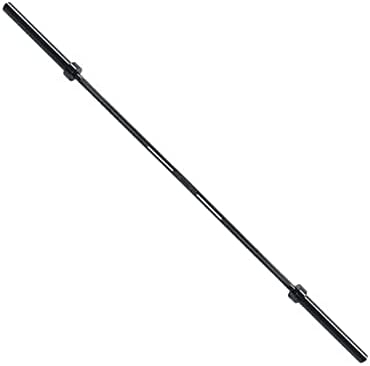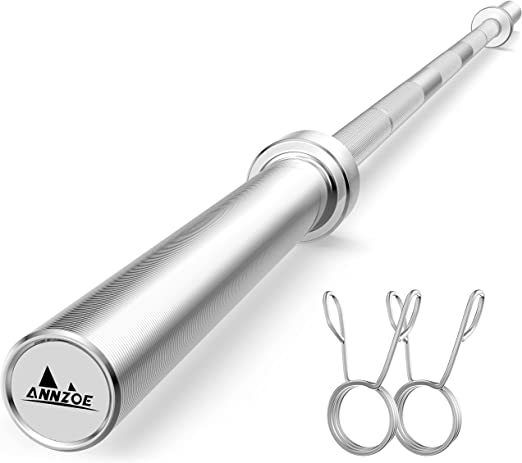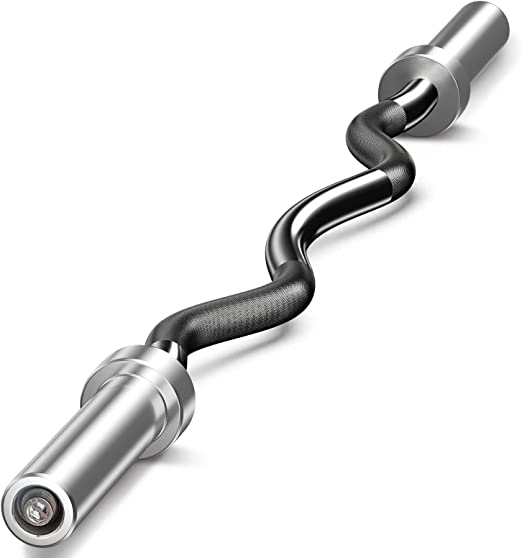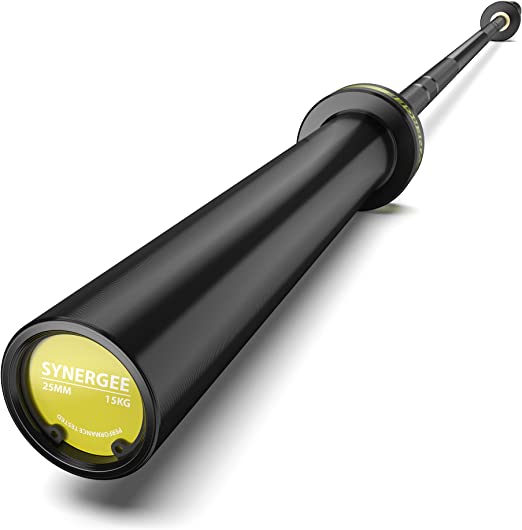Are you looking for an effective exercise to strengthen your back and build muscle mass? Look no further than the barbell row. In this article, we will explore the benefits, proper form, variations, and safety considerations of the barbell row, along with some useful tips for beginners and advanced lifters.
Introduction
When it comes to developing a strong and well-defined back, the barbell row is a go-to exercise for fitness enthusiasts and athletes alike. It is a compound exercise that primarily targets the muscles of the upper back, including the lats, rhomboids, and traps. Additionally, it engages the biceps, forearms, and core muscles, making it a great choice for overall upper body strength and stability.

Olympic Bar for Weightlifting and Power Lifting Barbell, 700-Pound, Black
What is a Barbell Row?
The barbell row is a weightlifting exercise performed with a barbell and emphasizes pulling the weight towards your body while maintaining proper posture and control. It mimics the motion of rowing a boat, hence its name. This exercise can be performed using an overhand grip (pronated grip) or an underhand grip (supinated grip) to target different muscles of the back and arms.
Benefits of Barbell Row
Incorporating barbell rows into your workout routine offers numerous benefits. Firstly, it helps to strengthen the muscles of the upper back, leading to improved posture and reduced risk of back pain. Secondly, it promotes muscle hypertrophy, contributing to a more sculpted and defined physique. Additionally, the barbell row enhances grip strength and enhances overall pulling power, which can be advantageous in various sports and daily activities.
Muscles Targeted
The barbell row is a compound exercise that targets several muscle groups simultaneously. The primary muscles worked during the barbell row include the latissimus dorsi (lats), rhomboids, trapezius, and erector spinae. These muscles play a crucial role in stabilizing the spine, supporting good posture, and facilitating movements involving the upper back and arms.
Secondary Muscles Targeted:
- Biceps brachii
- Brachialis
- Brachioradialis
- Forearm muscles
- Core muscles

Olympic Barbell Bar 7-Foot Weight Bar, Rated 700 lbs for Weight Capacity, Men’s Solid Iron Weighted Workout Barbell Weight Straight Weightlifting Technique Bar
Proper Form and Technique
To maximize the benefits and minimize the risk of injury, it is essential to execute the barbell row with proper form and technique. Follow these steps to perform the exercise correctly:
- Stand with your feet shoulder-width apart and slightly bend your knees.
- Bend forward from the hips while maintaining a neutral spine.
- Grip the barbell with an overhand or underhand grip, slightly wider than shoulder-width apart.
- Keep your back straight and engage your core.
- Pull the barbell towards your abdomen, leading with your elbows, and squeeze your shoulder blades together at the top of the movement.
- Lower the barbell back down in a controlled manner, keeping tension in your back muscles throughout the exercise.
- Repeat for the desired number of repetitions.
Remember to start with a weight that allows you to maintain proper form throughout the exercise. Gradually increase the weight as you become more comfortable and confident in your technique. It is crucial to prioritize quality over quantity, focusing on performing each repetition with control and full range of motion.
Variations of Barbell Row
The barbell row offers various variations that can help target specific areas of the back and provide diversity to your training routine. Here are a few popular variations:
- Underhand Grip Barbell Row: This variation, also known as the Yates row, involves using an underhand grip. It emphasizes the biceps and the lower portion of the lats, providing a different stimulus to the muscles compared to the traditional overhand grip.
- Pendlay Row: Named after weightlifting coach Glenn Pendlay, the Pendlay row involves starting each repetition from a dead stop on the ground. This variation focuses on explosive power and reinforces strict form.
- Wide-Grip Barbell Row: By widening your grip on the barbell, you place more emphasis on the outer portions of the back, particularly the upper lats and rear delts. This variation can help create a wider and more tapered back appearance.
- One-Arm Barbell Row: Using one arm at a time, this variation allows you to isolate each side of the back independently. It helps address muscular imbalances and provides a unique challenge to your core stability.

Olympic Barbell Curl Bar EZ Bar Strength Training Bar Threaded Chrome Barbell Bar for Weightlifting, Hip Thrusts, Squats and Lunges
Equipment and Setup
To perform the barbell row, you will need a barbell and weight plates. Here’s how to set up for the exercise:
- Place the barbell on the floor in front of you.
- Load the desired weight plates onto the barbell, making sure they are secure.
- Stand with your feet shoulder-width apart, ensuring that the barbell is directly in front of you.
Barbell Row vs. Dumbbell Row
While both the barbell row and dumbbell row target similar muscles, they offer slightly different benefits and challenges. The barbell row allows you to lift heavier weights, making it ideal for strength and power development. On the other hand, the dumbbell row requires greater stability and coordination, promoting unilateral strength and addressing muscle imbalances.
Common Mistakes to Avoid
To get the most out of your barbell row and prevent injuries, be mindful of these common mistakes:
- Rounding the Back: Maintain a neutral spine throughout the exercise and avoid rounding your back. This ensures proper engagement of the targeted muscles and reduces the risk of strain.
- Using Momentum: Avoid using momentum or jerking movements to lift the weight. Instead, focus on controlled and deliberate movements to effectively engage the muscles.
- Pulling with the Arms: The primary movement in the barbell row should come from the back muscles, not the arms. Avoid relying solely on your biceps to perform the exercise.
- Neglecting Proper Breathing: Breathe out as you pull the weight towards your body and inhale as you lower it back down. Proper breathing technique helps stabilize the core and optimize muscle engagement.

Synergee Commercial EZ Curl Olympic Bar Chrome & Black Phosphate with Powder Coated Brass Bushings Excellent for Bicep Curls and Triceps Extensions
Barbell Row for Beginners
If you’re new to the barbell row, here are some tips to help you get started:
- Begin with a lighter weight to focus on perfecting your form and technique.
- Gradually increase the weight as you become more comfortable and confident in your abilities.
- Seek guidance from a qualified fitness professional to ensure proper execution and avoid common mistakes.
Advanced Training Tips
For those looking to take their barbell row to the next level, consider incorporating these advanced training techniques:
- Supersets: Pair your barbell rows with other exercises that target opposing muscle groups, such as push-ups or overhead presses, to create a superset. This not only saves time but also increases the intensity of your workout.
- Progressive Overload: Continuously challenge your muscles by progressively increasing the weight you lift over time. This stimulates muscle growth and strength gains.
- Drop Sets: After completing a set with a heavy weight, immediately reduce the weight and perform another set until failure. This technique helps to push your muscles to fatigue and promotes muscle hypertrophy.
- Paused Reps: Incorporate pauses at the top of the movement during each repetition. This increases time under tension and enhances muscle activation.
- Single-Arm Barbell Row: Once you have mastered the traditional barbell row, try performing it with one arm at a time. This variation further engages the core and stabilizer muscles.
Barbell Row for Women
The barbell row is a highly effective exercise for women looking to strengthen their back and build overall upper body strength. It helps create a sculpted and defined physique while promoting good posture. Women can perform the barbell row using the same guidelines and variations mentioned earlier.

HIRALIY 47″ Olympic EZ Curl Barbell Bar for 2-inch Weight Plates Curling Bar for Weight Lifting Bicep Curl, 2 Spring Collars Included
Safety Considerations
While the barbell row is generally safe when performed with proper form, it is essential to consider the following safety precautions:
- Warm-up: Always warm up your body with dynamic stretches and lighter exercises before attempting the barbell row. This helps prepare your muscles and reduces the risk of injury.
- Proper Form: Focus on maintaining a neutral spine and avoid excessive rounding or arching of the back. Engage your core throughout the exercise to provide stability and protect your lower back.
- Start with Lighter Weights: Beginners should start with lighter weights to ensure proper form and technique. As you progress, gradually increase the weight while maintaining control and good form.
- Listen to Your Body: If you experience any pain or discomfort during the exercise, stop immediately and consult a healthcare professional. Proper form and gradual progression are essential for injury prevention.
Sample Barbell Row Workout
Here’s a sample workout incorporating the barbell row:
- Warm-up: Perform five minutes of light cardio, such as jogging or cycling, followed by dynamic stretches targeting the upper body and back.
- Barbell Rows: Perform three sets of 8-10 repetitions with a challenging weight. Focus on maintaining proper form and squeezing your back muscles at the top of each rep.
- Superset: Pair the barbell rows with push-ups. Perform three sets of 12-15 repetitions of push-ups immediately after each set of barbell rows.
- Wide-Grip Barbell Rows: Incorporate a set of wide-grip barbell rows to target the outer portions of your back. Perform two sets of 10-12 repetitions.
- Pendlay Rows: Finish your workout with two sets of Pendlay rows for explosive power and strict form. Perform 6-8 repetitions per set.
Remember to adjust the weight and repetitions based on your fitness level and goals.

Synergee Regional Olympic 20kg Men’s and 15kg Women’s Hard Chrome & Black Phosphate Barbells. Rated 1500lbs for Weightlifting and Powerlifting.
Conclusion
The barbell row is a versatile and effective exercise for building strength and muscle in the upper back, as well as targeting other muscles of the upper body. By incorporating proper form, variations, and progressive overload, you can achieve significant gains in strength and aesthetics. Remember to prioritize safety, listen to your body, and seek professional guidance if needed.
FAQs
Is the barbell row suitable for beginners?
Yes, it can be modified for beginners. Start with lighter weights and focus on mastering proper form before progressing to heavier loads.
Can I perform the barbell row with a Smith machine?
While the Smith machine provides stability, it limits the natural movement pattern of the barbell row. It is recommended to perform the exercise with a free barbell to engage stabilizer muscles and promote functional strength.
How often should I include barbell rows in my workout routine?
The frequency of these workouts depends on your overall training program and goals. It is generally recommended to include them 1-2 times per week, allowing for proper recovery between sessions.
Can the barbell row help improve my posture?
Yes, the barbell row can contribute to improved posture by strengthening the muscles responsible for maintaining proper alignment of the spine and shoulders. However, it is important to pair it with exercises that address muscle imbalances and incorporate overall postural correction.
Can I substitute the barbell row with other rowing exercises?
While there are various rowing exercises available, the barbell row offers unique benefits due to its ability to handle heavier loads and engage multiple muscle groups simultaneously. However, incorporating different rowing variations, such as dumbbell rows or cable rows, can add variety to your training routine.
Is the barbell row suitable for individuals with lower back issues?
Individuals with lower back issues should exercise caution when performing the barbell row. It is recommended to consult with a healthcare professional or a qualified trainer to ensure proper form and modifications that accommodate any existing conditions or limitations.
By following proper form, utilizing different variations, and progressively challenging yourself, you can make the barbell row a valuable addition to your strength training routine. Enjoy the benefits of a stronger back, improved posture, and enhanced upper body strength. Remember to prioritize safety, listen to your body, and consult a professional when necessary. Happy rowing!
